
2001.59.17.9.1 (Film negative)


2001.59.17.9.1 (Film negative)

Hugh E. Richardson
Hugh Richardson
1946-50
Lhasa > Sho
2001.59.17.9.1
55 x 55 mm
Negative film nitrate
Donated August 2001
The executors of the estate of Hugh E. Richardson
Hugh E. Richardson
Manual Catalogues - Notes on negative album (outer case) - 'INSCRIPTIONS ON RDO RINGS' (in black ink on white label) and 'Inscriptions & misc.' (in black ink on yellow label) is written in Richardson's hand on the cover of the negative album. [KC 21/9/2006]
Manual Catalogues - Notes on negative index - '59 - end'
Other Information - Location and History; Richardson discusses this pillar and provides traslation of the inscriptions on it in A Corpus of Early Tibetan Inscriptions , Hertford: Royal Asiatic Society (James G. Forlong Series No. XXIX), 1985, pp. 1-25. "The three connected inscriptions on the east, south, and north faces of the tall and graceful stone pillar standing on the south side of the road that runs past the village of Zhol at the foot of the Potala are the earliest surviving from the time of the kings. pillar stands on the south side of the road that runs past the village of Zhol at the foot of the Potala in Lhasa." (p.1) The Zhol Pillar is thought to have been erected during the reign of Khri srong lde brtsan (755-c.794 A.D) to mark the appointment of relatively unknown person, Nganlam Tagdrag Lukhong (Ngan-Lam Stag sgra klu-khong), as a minister. [KC 21/9/2006]
Hugh Richardson argues that the pillar was erected in 764 A.D or little later. The piller is inscribed on all four sides. For a full transcrition and translation, see: H. E. Ricardson, A Corpus of Early Tibetan Inscriptions" Hugh Richardson, A Corpus of Early Tibetan Inscriptions". Royal Asiatic Society, London. 1985. pp:1-25. [TS 4/4/2005]
For Citation use:
The Tibet Album.
"Middle section of the Sho inscription pillar"
05 Dec. 2006. The Pitt Rivers Museum.
<http://tibet.prm.ox.ac.uk/photo_2001.59.17.9.1.html>.
For more information about photographic usage or to order prints, please visit the The Pitt Rivers Museum.
© The Pitt Rivers Museum